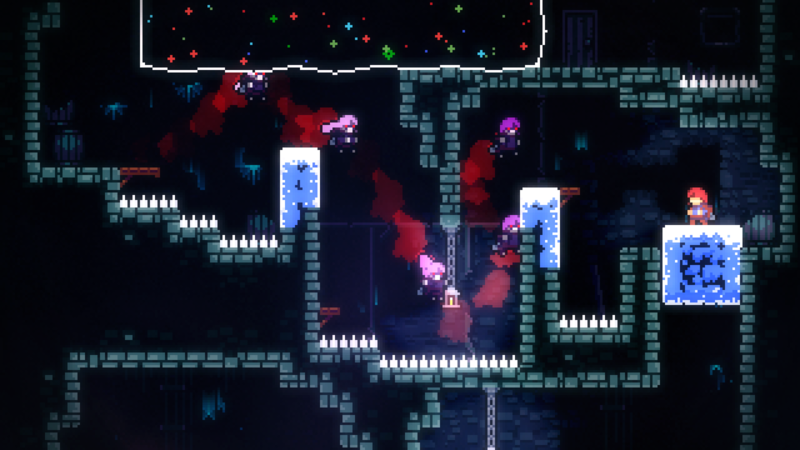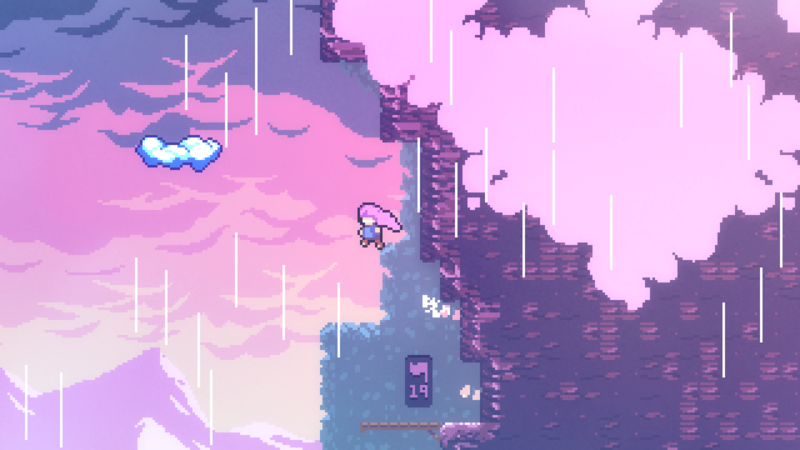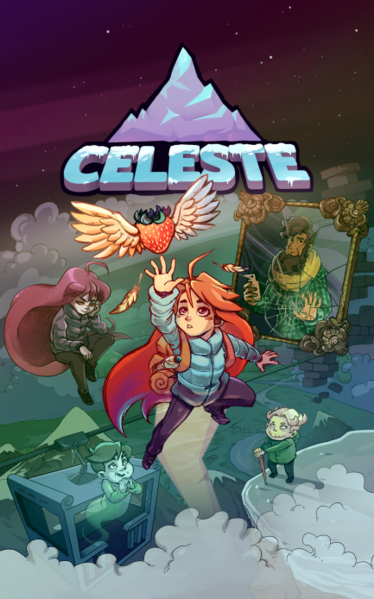On January 25, 2018, a small team led by Maddy Thorson and Noel Berry at Extremely OK Games (EXOK) released Celeste. The game quickly grew in popularity as a 2D platformer with smooth, intuitive movement, a heartfelt narrative, and a stellar soundtrack. The impressive levels of depth to the game also helped launch a vibrant speedrunning community as it is the 6th most active game on speedrun.com.
I want to dive deeper, though, into how the music in this game ties together those other elements. Between Lena Raine’s composition and Power Up Audio’s sound design, Celeste has been nominated for (and won) 7 different awards for its score. There will be spoilers for the first 7 chapters that comprise the main game, so go play Celeste first if you haven’t already.

Opening Anxieties
Chapter 1, Forsaken City, establishes our protagonist and her goal of climbing Celeste Mountain. Madeline travels through an abandoned town with run-down steam machinery as her theme plays in the background. Using a high-pitched synth in a major key, the theme sounds hopeful and optimistic.
Along the way, she meets a fellow climber, Theo, who mostly just wants pictures for his Instapix followers as opposed to actually reaching the summit. Eventually, she finds an old campsite with a memorial “dedicated to those who perished on the climb”. The music dies down, leaving just a piano repeating the same three notes softly, and the chapter ends.
Chapter 2, Old Site, introduces Madeline’s antagonist, who refers to herself as “Part of You”. The community has instead nicknamed her Badeline so I’ll use that name here. She casts doubt on Madeline’s journey and reflects her anxieties, uncovering Madeline’s true motivations for climbing Celeste Mountain.
About halfway through the chapter, she begins chasing Madeline by imitating the player’s movements, killing her if they touch. Here, the music intensifies as Badeline’s theme begins playing. The same synth for Madeline’s theme plays a similar melody, but lowered an octave and slowed down, creating a spookier, haunting melody that echoes on. The parallels between Madeline and Badeline are obvious through gameplay and music, though their ideas still clash.

Books and a Breakdown
Madeline makes it up to a hotel on the mountain for chapter 3, Celestial Resort, which is often considered harder than the next two or three chapters. A soft piano introduces the chapter as Madeline meets Mr. Oshiro, the hotel owner who appears to be a ghost. As the player progresses through the level, Oshiro continues to grow more insecure about Madeline not wanting to stay.
Badeline tells Oshiro that Madeline only wanted to help him to satiate her ego, which Madeline tries to argue against. A boss fight with an enraged Oshiro ensues, and the music grows violent. An 8-bit synth mixes with Oshiro’s ghastly theme as vibrant drumming intensifies the interaction.
Madeline: If I disappear now, Mr. Oshiro could have a meltdown.
Quote from Chapter 3 of Celeste.
And maybe I can actually do something good. For once.
Madeline was advised earlier by Theo not to try to help Oshiro with his anxieties for her own safety, but she refused, saying she wanted to “do something good for once”. So, Badeline was not that wrong in what she told Oshiro, leaving players with a sense that Madeline and Badeline are not as good and bad as they seem to be respectively.
Magnifying Mirrors
Chapter 5, Mirror Temple, delves into a visual representation of Madeline’s worries through a labyrinth of puzzles. The score is quiet, subtle, and devoid of either Madeline or Badeline’s themes. As a result, players feel alone and lost in the temple, allowing doubt about their own abilities to creep in. Madeline eventually gets sucked into a mirror where she enters rooms now occupied by seekers.
The temple amplifies the mountain’s ability to bring out a part of oneself that they despise, so these seekers represent Madeline’s worries about climbing the mountain. She feels they’re attacking her. The same vibrant drums from the boss fight with Oshiro return, indicating that Madeline feels as stressed now as she did then.
Revelation and Reform
Chapter 6, Reflection, opens with Madeline telling Part of Herself that she doesn’t need her anymore. Badeline is only slowing her down. It seems like Madeline has finally defeated Badeline as bold, optimistic synths come in. And then, Badeline breaks. She begins berating Madeline for thinking she can just neglect Part of Herself and Madeline begins having a panic attack. Badeline worsens her stress and they end up falling all the way back to the base of the mountain.
They meet again later, and the last boss fight in the game commences. The music swells louder and more complex than ever. Madeline and Badeline’s themes alternate now as the fight progresses. Everything feels so grand that this difficult section feels invigorating rather than discouraging to play.
Madeline tries to keep calming Badeline down until they are both beaten down. Madeline tells her counterpart that she was wrong to leave instead of helping her, and that they have to work together instead of separating again. They merge into one character and the player unlocks a new mechanic.
Chapter 7, Summit, ends the game by progressing through remixed versions of each of the previous chapters. Now each chapter’s music is accompanied by triumphant strings and a piano version of both character’s themes. The progression of the game becomes much more vertical as it feels like they are speeding up the mountain far faster together than they ever did separately.

The last section features a series of checkpoints counting down from 30 as players are encouraged to jump, dash, and climb their way to the summit. As the player reaches the final checkpoint, the score fades into the background so a sense of relief can wash over. Madeline was really able to climb the mountain. The player was able to climb the mountain.
Closing Thoughts
Aside from the contents of the music within each level, there are a couple other elements I wish to praise. No part of the score ever grows stale, since there are so many small variations of each chapter’s music. They never seem to loop on themselves.
The way EXOK handles anxiety in Celeste is remarkably original as well. Much of the story was created through Maddy Thorson’s own experiences, and there’s even a genuinely helpful strategy at the end of Chapter 4 for alleviating panic attacks, both for Madeline and the player.
Although Celeste’s narrative was primarily focused on anxiety and how to reckon with it, many trans people have found the narrative to describe their experiences very well too. In fact, this coincidence likely comes from Maddy’s experiences as well, since she came out as trans not long after Celeste released. In a follow-up DLC to Celeste, the last cutscene shows a trans pride flag on Madeline’s desk, confirming that Madeline the character is also trans, which is a nice touch.
Anyway, play Celeste if you haven’t before, so you can greater experience this indie masterpiece. And if you have played it before, replay it and see what connections you can make to your own life. Keep on a lookout for EXOK’s next game too, Earthblade.

